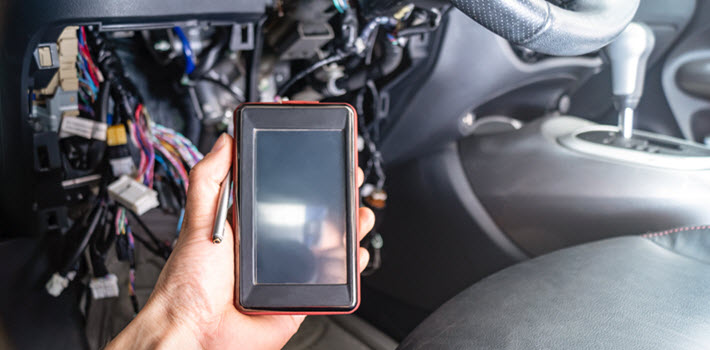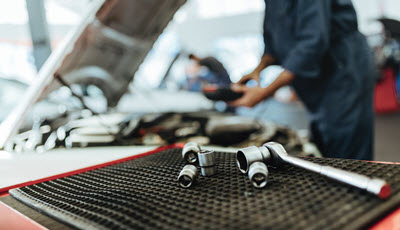-
Call Today:
(972) 418-1800
If your check engine light comes on, you know that it is an indication of problems ahead. You have probably heard your mechanic talk once or twice about registering a code indicative of the problem when you take your vehicle in. So what are these codes? They are part of the onboard diagnostic system in your vehicle, called OBD for short. There are hundreds of these codes, each of which offer a clue as to what is causing the problem in your vehicle. However, you don’t have to go to your mechanic in order to figure out what these codes mean. You can figure them out by yourself if you purchase an OBD code reader and you have the corresponding OBD-II code chart.

Knowing what code is triggered might give you peace of mind. For example, if you are able to read that the triggered code was simply a loose gas cap, that is something you can fix in a matter of seconds. Most of the time you will still want your mechanic to take a look, though, especially if the mechanic is the only one who can remove the check engine light once it is turned on. Nonetheless, knowing how to read the codes can be beneficial because it will help you to figure out when the issue is something small that you can manage, and when you need to call in a little professional assistance.
The onboard diagnostics trouble codes were originally created as a way to keep an eye on your emissions. The concepts utilizes an onboard computer designed to be in charge of Powertrain-related electronics. The information that is collected is stored in the memory unit of the engine control unit. Early on, in the 1980’s, there was no standard from one car manufacturer to another, so the variations were different and you had to take your car to a dealer or mechanic who worked specifically on your type of car.
California originally required all vehicles to have an interface by the start of the 1990s, which is what brought the modern OBD-II codes to vehicles. These codes made things much simpler. Using a standardized connector on every code, the price of scanners went down so that every mechanic could have one. Mechanics no longer needed to purchase $2,000 scanners with regular updates. More importantly, the computer on the car stored that data could be easily reviewed with a diagnostic scan tool.
A scan tool will retrieve all of the information supported by your on-board diagnostic system functions, but a code reader will only retrieve and clear some of these codes. High-end scanners give you real-time data, but this data comes with a great deal of finite detail that most drivers don’t need.
There are 10 different modes of operation available on these tools, but if you’re trying to check on the information yourself, you won’t need to know all of them. You will really only need to know the first four, which includes the data, reading the codes, and clearing the codes. The first mode, for example, shows you live sensor data in real-time. The second mode allows you to take a snapshot all of the data from the time that the trouble was originally logged. This can help you get close to the exact moment that the problem occurred so that you can have a much better idea of what caused it.
The third mode is what displays the codes which were stored in that tiny computer system. Most of these begin with the letter P and are followed by a sequence of four numbers. This is the information that tells you exactly what the problem was and where, and is arguably the most important mode for the average consumer. These codes can be looked up in a book or online to decipher what they mean.
The fourth mode is what allows you to erase those log codes once you have diagnosed and hopefully corrected the issue. This might be something you want to know how to do in the event that the problem is a loose gas cap which you can fix. If it is something more significant, you might want to let your trusted mechanic erase that code.
If you are able to access your car’s data by connecting  to scan tool or the code reader you have, all you have to do is turn your vehicle ignition on, turn on the tool if it isn’t already turned on, and follow the instructions. You should be able to see the codes and then compare them to the code log which will help you diagnose the issue. If you have a larger issue that you cannot rectify at home, bring your vehicle to us and we can help you to not only diagnose the issue but to erase the log codes and fix the problem. Come to Ultimate Bimmer Service at our location convenient to Carrolton and Dallas, TX, where we’ll be happy to help you address your check engine light and any associated codes.
to scan tool or the code reader you have, all you have to do is turn your vehicle ignition on, turn on the tool if it isn’t already turned on, and follow the instructions. You should be able to see the codes and then compare them to the code log which will help you diagnose the issue. If you have a larger issue that you cannot rectify at home, bring your vehicle to us and we can help you to not only diagnose the issue but to erase the log codes and fix the problem. Come to Ultimate Bimmer Service at our location convenient to Carrolton and Dallas, TX, where we’ll be happy to help you address your check engine light and any associated codes.